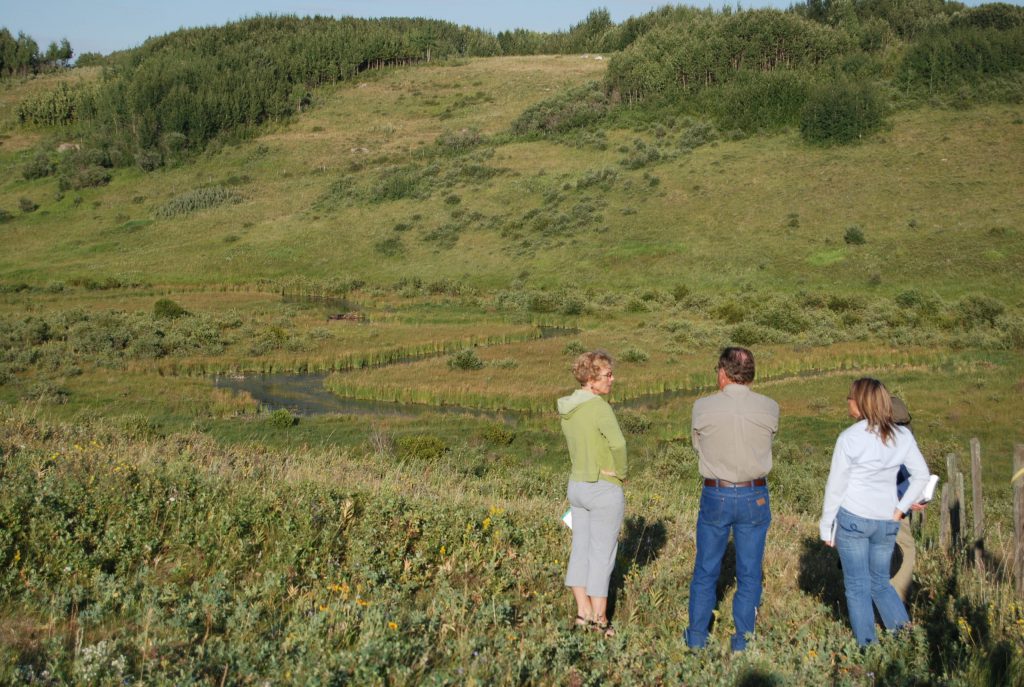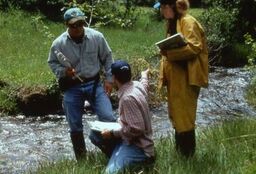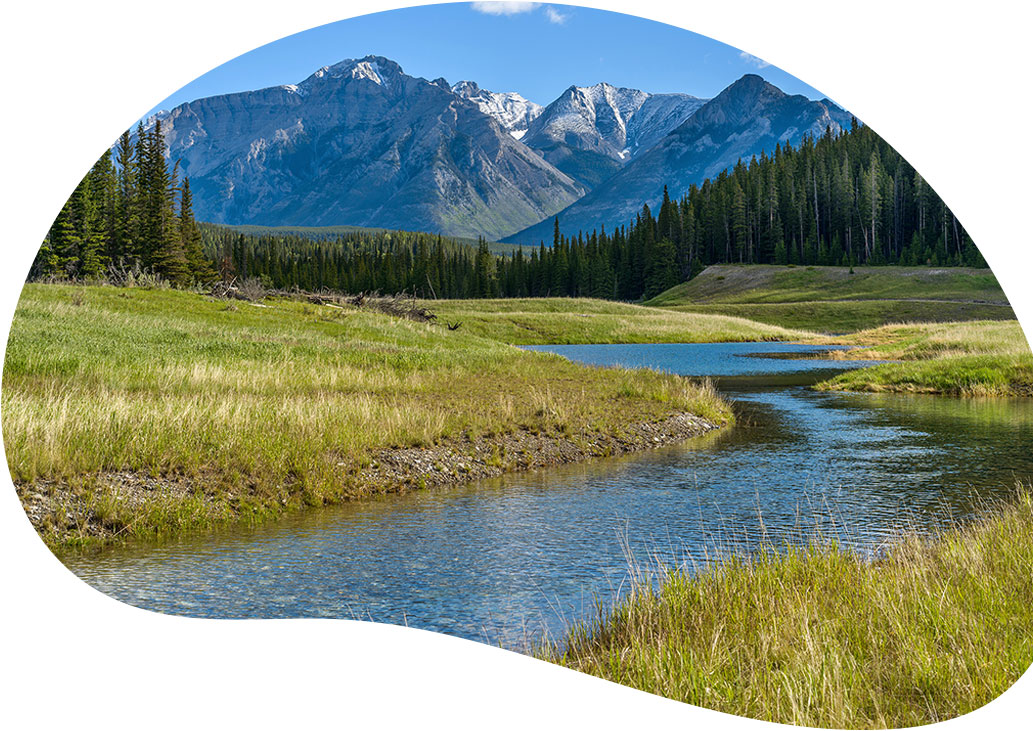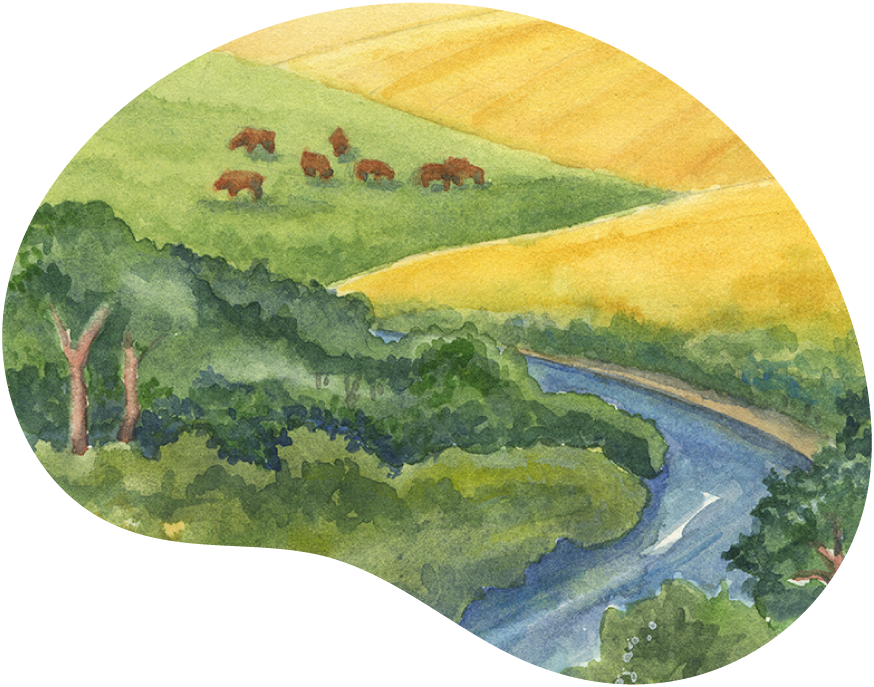What is Riparian Health?
Like people, riparian areas need to be healthy to function properly. Some of those functions include trapping sediments, recharging ground water, providing primary productivity, and supporting biodiversity. Cows and Fish is helping cattle producers, landowners, and their communities understand how healthy their riparian areas are, both on their individual operations and in their local watersheds. Understanding riparian health, or function, allows entire communities and individual producers to identify concerns and to proactively address specific land use issues. This willingness to face the issues fosters cooperation rather than conflict, and can help temper legislation and regulation.
What is a Riparian Health Assessment?
Riparian health assessment relies on visual observation, a little practice and fine-tuning your ‘eye’ to accurately interpret the health or function of a riparian area. Riparian health assessment helps you address the questions “Where am I?”, “Where do I want to go?”, and “Did I make it?” in terms of riparian health. Both vegetative and physical parameters are examined to provide information about the function and condition of that riparian area.
If you want to collect riparian health assessment data in the field, our Riparian Health Assessment Field Workbooks are a good option for landowners, community and stewardship group members and the general public. Riparian Health Assessment Field Workbooks combine ecological information on riparian areas and identification of these zones, with detailed steps on how to collect riparian health information and extra field sheets to collect data on multiple sites or monitor a site over a longer term. These handy field workbooks can be downloaded or ordered from our Publications page.
Download: Riparian Health Assessment for Streams and Small Rivers Field Workbook
Download: Riparian Health Assessment for Lakes and Wetlands Field Workbook
Riparian health assessment and inventory also:
- Creates awareness among producers, other landowners and their communities about riparian management issues in their local watersheds
- Helps landowners and communities take voluntary action by assisting local decision-makers develop strategies to find solutions to address local riparian issues
- Shows that the agricultural sector is willing to face the issues by first acknowledging the need to take stock or determine the current “state of the environment” of their watershed and individual operation
- Identifies the “Good News” stories of producers and other landowners already managing healthy riparian areas
- Tempers the need for legislation and regulation as proactive efforts by landowners and communities value cooperation over conflict by demonstrating their willingness to face riparian issues
- Helps communities and individuals monitor their progress in improving, maintaining and protecting riparian health in their watershed or operation
- Assists landowners to identify environmental risk and integrate that information into farm and ranch planning, taking stock of current conditions and identifying management options for improvement if required.
Collecting Riparian Health Data?
We strongly encourage those individuals who wish to use the riparian health assessment tool for scientific and benchmark purposes to contact us regarding training. This method is relatively simple, but it is important to gain consistent, appropriate techniques, particularly if the information is to be considered accurate and suitable for long-term comparisons. Describing riparian habitat and plant communities and how they respond to management and site conditions is an important part of understanding a riparian site. The following documents provide habitat and community classification and management information for riparian and wetland sites in Alberta to assist with identifying and classifying riparian plant communities and habitat types:
How Do We Deliver Riparian Health Assessments?

The purpose of riparian health assessment and inventory is to provide better information on riparian health or function to assist landowners and land managers make the best decisions to manage their riparian resources effectively. Combined with practical knowledge and wisdom about their own ranch, farm, land or watershed, riparian health information will help landowners and managers find better land management solutions. Read our “Riparian Health Assessment and Inventory” fact sheet to learn more.
Riparian health assessment and inventory are delivered:
- As part of a community-based process of initiative, usually on a local watershed, involving awareness and education, team building, tool and information building, and monitoring (see Cows and Fish Process for more information).
- After an invitation from a community of producer group, we meet with local Agricultural Service Board representatives, agricultural fieldmen, producer or community group leaders, and other local individuals to discuss potential riparian management tools the group can implement as part of their local voluntary plan to address land use issues in their local watershed.
- When the producer of community group decides to implement riparian health assessment, they determine which stream systems or watersheds to target as part of their community-based initiative. Then, at their invitation, we provide information on riparian areas and health at a local meeting, and ask the community to decide if they would like to proceed with riparian health assessment and inventory. If they want to proceed, they secure funding locally or through provincial and federal grants to help cover part of the cost of the riparian health inventories.
- We complete on-site visits with landowners who wish to participate and examine representative riparian areas on their land. Later in the year, individual landowners receive a confidential report that summarises what we found in terms of riparian health, with potential management strategies they may want to consider. The group or community typically receives a summary report, presented at a follow-up meeting, that portrays the health of the whole watershed and outlines possible next steps and suggested management strategies.
- Riparian health assessment/inventory is only one tool in the riparian management “tool box”. Because of the potential danger in riparian health assessment data being used to point fingers at improper management practices (those with degraded riparian health), Cows and Fish only proceeds with this tool after initial community meetings and decisions are made by the producers and community members to go ahead.
- We also host field days for local participants to learn more about riparian health assessment hands-on, provide riparian and grazing management information, and examine sites for demonstration or profile potential, depending on requests from the group or community. We encourage communities to monitor their progress and success at meeting their goals for healthy, sustainable operations and watersheds.
A Special Thanks goes to Paul Hansen, Bill Thompson, Tom Keith (Ecological Solutions Group LLC) and Bob Ehrhart (formerly with Riparian Wetland Research Program (RWRP), University of Montana), Montana USA, for all their support. Without the efforts and generosity provided to our program from Paul Hansen, Bill Thompson, Tom Keith and Bob Ehrhart, we would not have been able to achieve the success we have had in implementing riparian health inventory and assessment and riparian plant community classification work in Alberta. Their commitment and expertise has allowed our program to adopt, adapt and produce products that are assisting landowners and land managers improve their understanding of riparian ecosystems and make better decisions for their conservation and management throughout Alberta.





